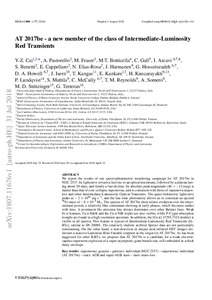AT 2017be-a new member of the class of intermediate-luminosity red transients
Cai YZ; Pastorello A; Fraser M; Botticella MT; Gall C; Arcavi I; Benetti S; Cappellaro E; Elias-Rosa N; Harmanen J; Hosseinzadeh G; Howell DA; Isern J; Kangas T; Kankare E; Kuncarayakti H; Lundqvist P; Mattila S; McCully C; Reynolds TM; Somero A; Stritzinger MD; Terreran G
AT 2017be-a new member of the class of intermediate-luminosity red transients
Cai YZ
Pastorello A
Fraser M
Botticella MT
Gall C
Arcavi I
Benetti S
Cappellaro E
Elias-Rosa N
Harmanen J
Hosseinzadeh G
Howell DA
Isern J
Kangas T
Kankare E
Kuncarayakti H
Lundqvist P
Mattila S
McCully C
Reynolds TM
Somero A
Stritzinger MD
Terreran G
OXFORD UNIV PRESS
Julkaisun pysyvä osoite on:
https://urn.fi/URN:NBN:fi-fe2021042720648
https://urn.fi/URN:NBN:fi-fe2021042720648
Tiivistelmä
We report the results of our spectrophotometric monitoring campaign for AT 2017be in NGC 2537. Its light curve reveals a fast rise to an optical maximum, followed by a plateau lasting about 30 d, and finally a fast decline. Its absolute peak magnitude (M-r similar or equal to -12 mag) is fainter than that of core-collapse supernovae, and is consistent with those of supernova impostors and other intermediate-luminosity optical transients. The quasi-bolometric light-curve peaks at similar to 2 x 10(40) erg s(-1), and the late-time photometry allows us to constrain an ejected Ni-56 mass of similar to 8 x 10(-4)M(circle dot). The spectra of AT 2017 be show minor evolution over the observational period, a relatively blue continuum showing at early phases, which becomes redder with time. A prominent H alpha emission line always dominates over other Balmer lines. Weak Fe II features, Can H&K, and the Ca II NIR triplet are also visible, while P-Cygni absorption troughs are found in a high-resolution spectrum. In addition, the [Ca II] lambda lambda 7291, 7324 doublet is visible in all spectra. This feature is typical of intermediate-luminosity red transients (ILRTs), similar to SN 2008S. The relatively shallow archival Spitzer data are not particularly constraining. On the other hand, a non-detection in deeper near-infrared HST images disfavours a massive Luminous Blue Variable eruption as the origin for AT 2017be. As has been suggested for other ILRTs, we propose that AT 2017be is a candidate for a weak electron-capture supernova explosion of a superasymptotic giant branch star, still embedded in a thick dusty envelope.
Kokoelmat
- Rinnakkaistallenteet [27094]
